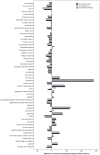NSFC health research funding and burden of disease in China
- PMID: 25369330
- PMCID: PMC4219749
- DOI: 10.1371/journal.pone.0111458
NSFC health research funding and burden of disease in China
Abstract
Background: Allocation of health research funds among diseases has never been evaluated in China. This study aimed to examine the relationship between disease-specific funding levels of National Nature Science Foundation of China (NSFC), the main governmental resource for health research in China, and burden of disease.
Methods: Funding magnitudes for 53 diseases or conditions were obtained from the website of NSFC. Measures of disease burden, mortality, years of life lost (YLLs) and disability-adjusted life years (DALYs), were derived from the Global Burden of Disease Study 2010. The relationship between NSFC funding and disease burden was analyzed with univariate linear regression. For each measure associated with funding, regression-derived estimates were used to calculate the expected funds for each disease. The actual and expected funds were then compared. We also evaluated the impacts of changes of disease burden metrics since 1990, and differences from the world averages on NSFC funding.
Results: NSFC health research funding was associated with disease burden measured in mortality (R = 0.33, P = 0.02), YLLs (R = 0.39, P = 0.004), and DALYs (R = 0.40, P = 0.003). But none of the changes of mortality (R = 0.22, P = 0.12), YLLs (R = -0.04, P = 0.79) and DALYs (R = -0.003, P = 0.98) since 1990 was associated with the funding magnitudes. None of the differences of mortality (R = -0.11, P = 0.45), YLLs (R = -0.11, P = 0.43) and DALYs (R = -0.12, P = 0.38) from that of the concurrent world averages were associated with the funding magnitudes. Measured by DALY, stroke and COPD received the least funding compared to expected; while leukemia and diabetes received the most funding compared to expected.
Conclusion: Although NSFC funding were roughly associated with disease burden as measured in mortality, YLLs and DALYs. Some major diseases such as stroke were underfunded; while others such as leukaemia were overfunded. Change of disease burden during the last 20 years and country-specialized disease burden were not reflected in current allocation of NSFC funds.
Conflict of interest statement
Figures


References
-
- Van Noorden R (2014) China tops Europe in R&D intensity. Nature 505: 144–145. - PubMed
-
- Qiu J (2014) China goes back to basics on research funding. Nature 507: 148–149. - PubMed
-
- Morello L, Morrison J, Reardon S, Tollefson J, Witze A (2014) Obama's budget request falls flat. Nature 507: 147–148. - PubMed
-
- Shi Y, Rao Y (2010) China's research culture. Science 329: 1128. - PubMed
-
- Cao C, Li N, Li X, Liu L (2013) Science and Government. Reforming China's S&T system. Science 341: 460–462. - PubMed
Publication types
MeSH terms
LinkOut - more resources
Full Text Sources
Other Literature Sources

